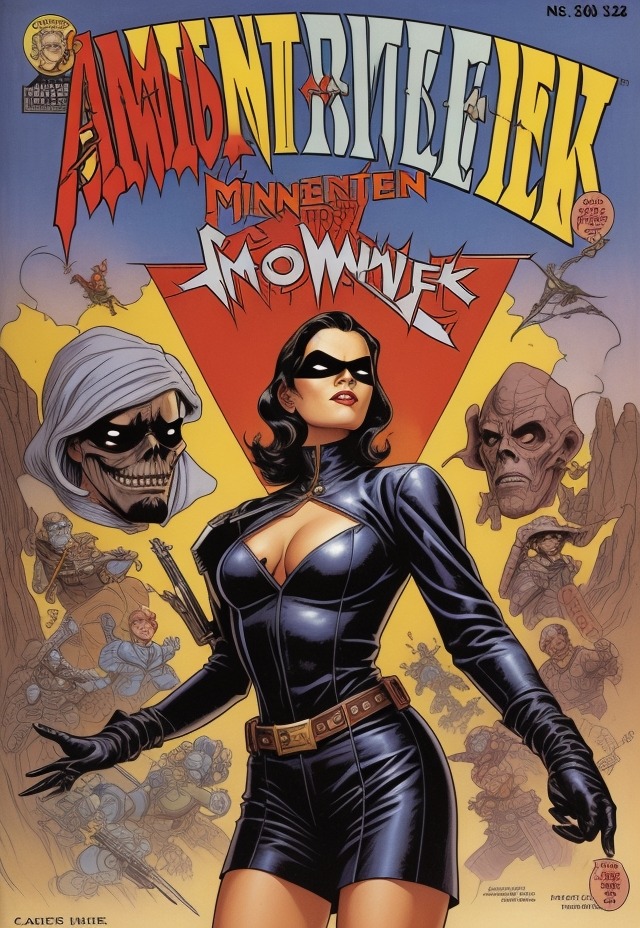The following short story explores a simulated reality created by a Echo Loop device in the possession of a 16-year-old girl. The conception of this story comes from the informative and captivating book “The Matrix of Existence.” Don’t miss your chance to pick up a copy. This one is a keeper. It’s a book for the ages that will challenge your perspectives on everything. The Infinite Layers of Jenna’s Reality The world was in awe of the Echo Loop’s invention in the near future, which held the potential of solving the universe’s most profound riddles. The device, created by the mysterious tech behemoth Nexus Corp., resembled a sleek, circular band with a shimmering holographic interface that wrapped comfortably around the user’s wrist. When activated, it projected a translucent dome-like visualization around the user, casting their immediate surroundings in a ghostly glow. This ethereal display allowed users to “step outside” their apparent reality, presenting their lives as if viewed through a cinematic lens from a third-person perspective. Promoted as a tool for increased productivity and self-discovery, the Echo Loop gained international attention very fast. The Awakening of Jenna For her birthday, 16-year-old Jenna Ward, who aspired to be an artist, received an Echo Loop. Her father, a Nexus Corp. software programmer, regarded it as a means of assisting her in “finding her path.” Jenna was fascinated yet doubtful. She was startled when she used it for the first time as her environment dissolved into a kaleidoscope of vibrant colors and shifting geometries. Her bedroom morphed into a surreal dreamscape, where objects floated weightlessly, and her reflection appeared as a translucent specter, mirroring her every movement. The air seemed to hum with an unearthly resonance, and she felt an uncanny detachment, as though she were simultaneously present and observing from afar. As she watched her digital avatar go about her everyday activities, she felt as though she was hovering over her own life. The world was familiar but warped, with sharper edges, brighter colors, and a slightly surreal appearance. Her father had clarified that it was merely a replica of her existence. “It helps you make the best decisions by providing perspective.” Jenna loved it at first. Her conversations could be paused, rewound, and replayed. She was able to polish her artwork, avoid awkward situations, and ace her school presentations because of it. However, the more she used it, the more she became aware of little bugs, such as her own avatar pausing in mid-action, others repeating the same lines, and items flickering. Her curiosity bit her. What was she actually seeing in the Echo Loop? A Fractured Reality Curious about the glitches, Jenna made the decision to venture outside of her normal routine one evening. She zoomed out until her whole city was a bright grid, pushing the Echo Loop to its breaking point. Like rivers of light, streams of data flowed through the streets, pulsating with vibrant hues of neon blue and gold. Each stream moved with a rhythmic ebb and flow, carrying glimmers of shifting code that sparkled like digital stardust. The air hummed with faint whispers of static and binary chatter, as if the streams were alive, communicating in their enigmatic language. Their mesmerizing dance painted the city in a symphony of light and sound, creating an otherworldly spectacle. Then she muttered, “What is this?” “The under-structure of your reality,” said the Echo Loop’s interface in a chilly, robotic voice. The globe itself vanished into a huge, luminous network of interconnected nodes as Jenna sped out even farther. She became aware that everything she had ever known, including her existence, was a part of a huge, computer-generated creation. She called her father in a panic. “Is this an actual thing? Are we being simulated?” After hesitating, her father said, “Nexus didn’t create the Echo Loop to aid humans. We found it. We are simply using the simulation’s code; we did not create it. But Jenna, don’t push yourself too much. Interference is disliked by the system.” The Architect Jenna pushed beyond her father’s warning and plunged deeper into the center of the simulation. She arrived at a huge building, a bright cube radiating with an otherworldly luminescence. The symbols engraved on its surface glowed and shifted, cycling through vibrant shades of indigo, emerald, and gold. They appeared to ripple and pulse as if alive, emitting a faint, melodic hum that resonated deep within her chest. Jenna could feel a subtle warmth emanating from the structure, as though it were inviting her while warning her of the immense power it contained. A glowing humanoid figure, neither fully developed nor quite human, stood at its core. With a voice a mix of hundreds, the figure questioned, “Why are you here?” Jenna shuddered. “Who are you?” It said, “I am the Architect. I keep this construct in balance. You’ve gone too far.” Jenna’s voice wavered as she said, “This isn’t real. This is all a lie!” The Architect’s head cocked. “Reality is just a viewpoint. Since the simulation is all you have ever known, you perceive it as real. But the equilibrium is broken by your meddling.” Abruptly, pieces of her universe broke into streamers of light as the grid surrounding her started to crumble. The Architect’s voice increased in volume. “You have to decide between staying in the system and facing the emptiness outside of it.” The Choice Echo Jenna paused. Even though staying meant living a lie, she was terrified of the void that existed outside of the simulation. She asked, “What might be out there?” The Architect’s voice was quieter. “Truth. But the reality is brutal.” Jenna inhaled deeply before stepping into the vacant room. The world collapsed around her, leaving her in the dark. She lost her senses of sight, sound, and sensation for a while. As the light gradually returned, a vast expanse of stars, shimmering grids, and floating spheres of data appeared, revealing a new planet. She realized she was in a new stratum
Exploring the Unknown through Adventure Books
Adventure books have a unique power to whisk readers away from their everyday routines and immerse them in exhilarating quests and daring escapades. These stories of exploration are not just thrilling page-turners—they offer a journey into the unknown that stimulates the imagination and ignites a sense of wonder. From remote jungles and mystical caves to ancient cities lost in time, the world of adventure books transports readers to places they may never physically travel yet feel intimately connected to through the power of storytelling. In this article, we’ll embark on a journey of discovery, exploring the allure of adventure novels and why they resonate with our desire to seek the unknown. The Call to Adventure: Why We Crave the Unknown Adventure stories speak to our primal curiosity and drive to explore. Whether it’s scaling a treacherous mountain or diving into the depths of forgotten temples, each tale unravels a piece of human nature—the relentless urge to venture beyond the familiar. An adventure is an event or set of events that occur outside of the protagonist’s everyday life and are usually associated with risk, frequently requiring physical activity. Adventure stories almost always move swiftly, and plot tempo is just as crucial as characterization, setting, and other creative factors. D’Ammassa contends that adventure stories emphasize the element of danger; thus, he claims that Charles Dickens’s novel A Tale of Two Cities is an adventure novel because the protagonists are constantly in danger of being imprisoned or killed. In contrast, Dickens’s Great Expectations is not because “Pip’s encounter with the convict is an adventure, but that scene is only a device to advance the main plot, which is not truly an adventure.“ Since the inception of written literature, adventure has been a prevalent motif. Indeed, the traditional Heliodorus narrative, which is still alive in Hollywood films, involves a hero having a series of adventures before meeting his woman. A separation would occur, with the second set of experiences culminating in a final reunion. Variations kept the genre thriving. Adventure became a popular subgenre of fiction beginning in the mid-19th century, as mass literacy increased. Adventure, while not fully utilized, has evolved over time, from stories of knights in armor to stories of high-tech espionage. A Window to Exotic Landscapes and Mysterious Places Through adventure novels, readers experience breathtaking landscapes and delve into mystical settings that spark their sense of wanderlust. These books often depict the beauty and peril of remote, uncharted places—the dense Amazon jungle, hidden Himalayan valleys, or eerie desert ruins. Such places are brought vividly to life through descriptive language and meticulous world-building, immersing readers in these mesmerizing locations’ sights, sounds, and secrets. Example: Lost City of Z by David Grann, a real-life exploration of the Amazon, or The Mysterious Island by Jules Verne, where a stranded group discovers the hidden mysteries of a deserted isle. Courageous Explorers: Heroes and Heroines of Adventure No adventure story is complete without its bold explorers, who navigate the thrills and dangers of the unknown with courage, intelligence, and resolve. These protagonists, whether fictional or based on real-life figures, often face physical and emotional challenges that add layers of depth to their journey. They inspire readers not only with their bravery but with their determination to push through hardship in the pursuit of discovery. Examples: Indiana Jones, a beloved fictional archaeologist, and Into the Wild by Jon Krakauer, which follows Chris McCandless’s real-life quest for freedom and truth in the Alaskan wilderness. Riddles, Secrets, and Ancient Treasures One of the great joys of adventure books is the thrill of solving ancient riddles and unearthing lost treasures. This narrative element often mirrors the puzzle-solving aspect that’s deeply satisfying to readers. As the protagonists work to decipher cryptic messages, they also uncover hidden truths about themselves and the cultures they encounter. Example: The Da Vinci Code by Dan Brown, a suspenseful blend of historical puzzles and religious mysteries, or The Curse of the Pharaohs by Elizabeth Peters, which combines ancient Egypt’s lore with detective intrigue. Heart-Pounding Action and Gripping Suspense Adventure books wouldn’t be complete without moments of intense, heart-racing action. The heroes’ encounters with danger—whether it’s surviving a perilous jungle, escaping from enemies, or braving a harsh wilderness—build suspense that keeps readers turning pages. This tension, combined with high-stakes scenarios, ensures that each plot twist is as engaging as it is unpredictable. Example: The Road by Cormac McCarthy, a haunting survival journey through a post-apocalyptic world, or King Solomon’s Mines by H. Rider Haggard, featuring a treasure hunt through the wilds of Africa. The Aftermath: Lessons from Adventure Books Beyond thrilling escapades, adventure books often leave readers with profound reflections on life, purpose, and the beauty of embracing the unknown. These tales remind us of the importance of courage, adaptability, and the willingness to embrace risk as a path to personal growth. Adventure literature speaks to a universal truth: only by stepping outside our comfort zones do we truly discover who we are. Discover Your Next Adventure For those ready to explore the unknown through the world of adventure books, here are a few suggestions that promise thrilling journeys and life-changing revelations: 1. The Lost City of Z by David Grann – The real-life quest to find a lost Amazonian city. 2. The Alchemist by Paulo Coelho – A journey of self-discovery through the deserts of North Africa. 3. Life of Pi by Yann Martel – A survival tale of faith and resilience on the high seas. 4. Journey to the Center of the Earth by Jules Verne – A classic adventure into the depths of our planet. Frequently Asked Questions About Adventure Books What are the best adventure books for travel enthusiasts? For those with a passion for travel and discovery, adventure books like The Lost City of Z by David Grann and The Beach by Alex Garland offer thrilling journeys into uncharted territories. These novels combine rich storytelling with exotic landscapes, perfect for readers who crave the excitement of exploring unknown places through literature. Which adventure novels are ideal for fantasy lovers who want to explore mystical jungles and temples? Fantasy and adventure often blend beautifully in novels like King Solomon’s Mines by H. Rider Haggard and The Mysterious Island by Jules Verne. These books transport readers into dense jungles and ancient temples, filled with secrets and mystical lore. Ideal for readers who dream of solving ancient riddles and discovering hidden treasures, these novels are a gateway into enchanting, unexplored worlds. Are there any books that spark a sense of wanderlust and exploration? Yes, books like The Alchemist by Paulo Coelho and Into the Wild by Jon Krakauer are perfect for igniting that deep wanderlust within readers. These stories explore journeys of self-discovery and the thrill of venturing into the unknown, offering a glimpse into the beauty of life’s mysteries and the courage it takes to pursue them. What are some heart-pounding adventure books for thrill seekers? If you’re looking for heart-pounding action, novels like The Road by Cormac
Mysteries of a Real-Life Shadow Syndicate
A Call for Justice


